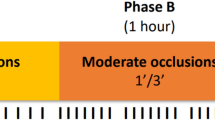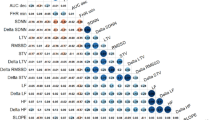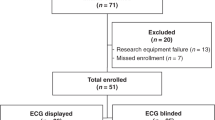Abstract
The aim of this study was to determine whether there is a relationship between changes in PR-RR correlation of the fetal ECG and progressive changes in fetal acid-base status and blood pressure (BP) during repeated umbilical occlusion. Chronically instrumented fetal sheep at 126.8 ± 0.6 d (mean± SEM) were randomized to receive 1 min of total umbilical cord occlusion either every 5 min for 4 h (1:5 group; n = 8), or every 2.5 min until BP fell <2.7 kPa (20 mm Hg) on two successive occlusions (1:2.5 group; n = 8). The PR-RR correlation was determined in 5- or 2.5-min intervals. Umbilical cord occlusion caused variable decelerations with initial sustained hypertension. In the 1:5 group BP remained elevated throughout, and there was little change in acid-base status (pH = 7.34 ± 0.07, base deficit = 1.3 ± 3.9 after 4 h). In contrast, after the third occlusion the 1:2.5 group showed progressive hypotension during occlusions, and severe progressive metabolic acidemia (pH 6.92 ± 0.1, base deficit 17.0 ± 4.7 mmol/L after the last occlusion). In both groups, the PR-RR relationship switched from positive to negative with the onset of occlusions, then reverted to positive after a variable interval. In the 1:2.5 group later reversion of the PR-RR to positive was associated with earlier and more prolonged hypotension during the middle and end of the occlusion series (p < 0.001). We conclude that the initial switch to a negative PR-RR relationship during repetitive umbilical occlusion was due to a reflex-mediated response unrelated to fetal acidosis or hypotension. Both stable well compensated fetuses and severely hypoxic, hypotensive fetuses subsequently showed a positive PR-RR correlation.
Similar content being viewed by others
Log in or create a free account to read this content
Gain free access to this article, as well as selected content from this journal and more on nature.com
or
Abbreviations
- BD :
-
base deficit
- MAP :
-
mean arterial blood pressure
- MWU :
-
Mann-Whitney U test
References
Vintzileos AM, Nochimson DJ, Guzman ER, Knuppel RA, Lake M, Schifrin BS 1995 Intrapartum electronic fetal heart rate monitoring versus intermittent auscultation: a meta-analysis. Obstet Gynecol 85: 149–155.
Thacker SB, Stroup DF, Peterson HB 1995 Efficacy and safety of intrapartum electronic fetal monitoring: an update. Obstet Gynecol 86: 613–620.
Nelson KB, Dambrosia JM, Ting TY, Grether JK 1996 Uncertain value of electronic fetal monitoring in predicting cerebral palsy. N Engl J Med 334: 613–618.
Murray HG 1986 The fetal electrocardiogram: current clinical developments in Nottingham. J Perinat Med 14: 399–404.
Mohajer MP, Sahota DS, Reed NN, Chang A, Symonds EM, James DK 1994 Cumulative changes in the fetal electrocardiogram and biochemical indices of fetal hypoxia. Eur J Obstet Gynecol Reprod Biol 55: 63–70.
Luzietti R, Erkkola R, Hasbargen U, Mattson LA, Thoulon JM, Rosen KG 1997 European Community Multicentre Trial "Fetal ECG Analysis during Labour": the P-R interval. J Perinat Med 25: 27–34.
Widmark C, Lindecrantz K, Murray H, Rosen KG 1992 Changes in the PR, RR intervals and ST waveform of the fetal lamb electrocardiogram with acute hypoxemia. J Dev Physiol 18: 99–103.
van Wijngaarden WJ, de Haan HH, Sahota DS, James DK, Symonds EM, Hasaart TH 1996 Changes in the PR interval-fetal heart rate relationship of the electrocardiogram during fetal compromise in chronically instrumented sheep. Am J Obstet Gynecol 175: 548–554.
de Haan HH, Gunn AJ, Gluckman PD 1997 Fetal heart rate changes during brief repeated umbilical cord occlusion do not reflect cardiovascular deterioration in fetal lambs. Am J Obstet Gynecol 176: 8–17.
de Haan HH, Gunn AJ, Williams CE, Gluckman PD 1997 Brief repeated umbilical cord occlusions cause sustained cytotoxic cerebral edema and focal infarcts in near-term fetal lambs. Pediatr Res 41: 96–104.
Mallard EC, Gunn AJ, Williams CE, Johnston BM, Gluckman PD 1992 Transient umbilical cord occlusion causes hippocampal damage in the fetal sheep. Am J Obstet Gynecol 167: 1423–1430.
Warner MR, Loeb JM 1987 Reflex regulation of atrioventricular conduction. Am J Physiol 252:H1077–H1085.
Jensen A, Lang U 1992 Foetal circulatory responses to arrest of uterine blood flow in sheep: effects of chemical sympathectomy. J Dev Physiol 17: 75–86.
Jensen A, Kunzel W, Kastendieck E 1987 Fetal sympathetic activity, transcutaneous PO2, and skin blood flow during repeated asphyxia in sheep. J Dev Physiol 9: 337–346.
Bartelds B, Van Bel F, Teitel DF, Rudolph AM 1993 Carotid, not aortic, chemoreceptors mediate the fetal cardiovascular response to acute hypoxemia in lambs. Pediatr Res 34: 51–55.
Giussani DA, Spencer JA, Moore PJ, Bennet L, Hanson MA 1993 Afferent and efferent components of the cardiovascular reflex responses to acute hypoxia in term fetal sheep. J Physiol 461: 431–449.
Jensen A, Hanson MA 1995 Circulatory responses to acute asphyxia in intact and chemodenervated fetal sheep near term. Reprod Fertil Dev 7: 1351–1359.
Hirata A 1990 Effect of hypoxia on electrical activity of atrioventricular nodal cells and atrial cells of the rabbit's heart. J Electrocardiol 23: 69–76.
Clemo HF, Bourassa A, Linden J, Belardinelli L 1987 Antagonism of the effects of adenosine and hypoxia on atrioventricular conduction time by two novel alkylxanthines: correlation with binding to adenosine A1 receptors. J Pharmacol Exp Ther 242: 478–484.
Rosen KG, Hrbek A, Karlsson K, Kjellmer I 1986 Fetal cerebral, cardiovascular and metabolic reactions to intermittent occlusion of ovine maternal placental blood flow. Acta Physiol Scand 126: 209–216.
Mohajer MP, Sahota DS, Reed NN, James DK 1995 Atrioventricular block during fetal heart rate decelerations. Arch Dis Child Fetal Neonat Ed 72:F51–F53.
Pardi G, Tucci E, Uderzo A, Zanini D 1974 Fetal electrocardiogram changes in relation to fetal heart rate patterns during labor. Am J Obstet Gynecol 118: 243–250.
Marvell CJ, Kirk DL, Jenkins HM, Symonds EM 1980 The normal condition of the fetal electrocardiogram during labour. Br J Obstet Gynaecol 87: 786–796.
Yeh MN, Morishima HO, Niemann WH, James LS 1975 Myocardial conduction defects in association with compression of the umbilical cord. Experimental observations on fetal baboons. Am J Obstet Gynecol 121: 951–957.
Boyden PA, Dresdner KP 1990 Electrogenic Na(+)-K+ pump in Purkinje myocytes isolated from control noninfarcted and infarcted hearts. Am J Physiol 258:H766–H772.
Author information
Authors and Affiliations
Additional information
Supported by the Health Research Council of New Zealand, the Auckland Medical Research Foundation, the New Zealand Lotteries Board, and U.S. Public Health Service Grant RO1-HD-32752.
Rights and permissions
About this article
Cite this article
Westgate, J., Gunn, A., Bennet, L. et al. Do Fetal Electrocardiogram PR-RR Changes Reflect Progressive Asphyxia after Repeated Umbilical Cord Occlusion in Fetal Sheep?. Pediatr Res 44, 297–303 (1998). https://doi.org/10.1203/00006450-199809000-00006
Received:
Accepted:
Issue date:
DOI: https://doi.org/10.1203/00006450-199809000-00006
This article is cited by
-
A systematic review of cardiac time intervals utilising non-invasive fetal electrocardiogram in normal fetuses
BMC Pregnancy and Childbirth (2018)
-
Comparison of ECG-based physiological markers for hypoxia in a preterm ovine model
Pediatric Research (2016)
-
Design and Testing of a Percutaneously Implantable Fetal Pacemaker
Annals of Biomedical Engineering (2013)
-
Foetal ECG and STAN technology—a review
European Clinics in Obstetrics and Gynaecology (2005)



